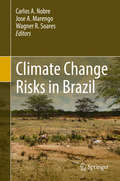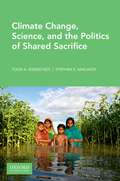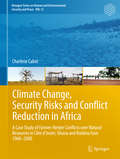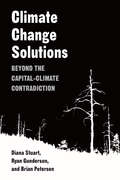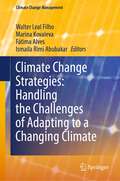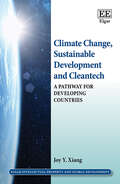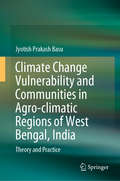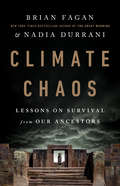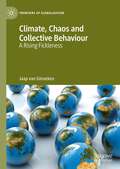- Table View
- List View
Climate Change Research, Policy and Actions in Indonesia: Science, Adaptation and Mitigation (Springer Climate)
by Joni Jupesta Riyanti Djalante Edvin AldrianThis edited volume reviews the latest advances in policies and actions in understanding the science, impacts and management of climate change in Indonesia. Indonesia is one of the most vulnerable countries to climate change due to its geographical, physical, and social-economic situations. There are many initiatives to understand and deal with the impacts in the country. The national government has issued key guiding policies for climate change. International agencies together with local stakeholders are working on strengthening the capacity in the policy formulations and implement actions to build community resilience. Universities are conducting research on climate change related at different scales. Cities and local governments are implementing innovations in adapting to the impacts of climate change and transiting toward green economy. This book summarizes and discusses the state-of-the-art regarding climate change in Indonesia including adaptation and mitigation measures. The primary readership of the book includes policy makers, scientists and practitioners of climate change actions in Indonesia and other countries facing similar challenges.
Climate Change Risks in Brazil
by Carlos A. Nobre Jose A. Marengo Wagner R. SoaresThis book maps extreme temperature increase under dangerous climate change scenarios in Brazil and their impacts on four key sectors: agriculture, health, biodiversity and energy. The book draws on a careful review of the literature and climate projections, including relative risk estimates. This synthesis summarizes the state-of-the-art knowledge and provides decision-makers with risk analysis tools, to be incorporated in public planning policy, in order to understand climate events which may occur and which may have significant consequences.
Climate Change Science: Volume 1 - The Physical Climate
by G. Thomas Farmer John CookAn introduction to the principles of climate change science with an emphasis on the empirical evidence for climate change and a warming world. Additional readings are given at the end of each chapter. A list of "Things to Know" opens each chapter. Chapters are arranged so that the student is first introduced to the scientific method(s), examples of the use of the scientific method from other sciences drawn from the history of science with an emphasis on climate science. Climate science is treated in each chapter based on the premise of global warming. Chapter treatments on the atmosphere. biosphere, geosphere, hydrosphere, and anthroposphere and their inter-relationships are given.
Climate Change, Science, and The Politics of Shared Sacrifice
by Todd Eisenstadt Stephen MacAvoyDesigned for undergraduate courses that cover climate change politics within environmental studies, politics, and international relations courses, Climate Change, Science, and The Politics of Shared Sacrifice integrates science and policy within each chapter by considering technical issues as well as their political implications. It reflects the recent changes in US climate policy under President Biden, as well as by other international actors, and covers recent technological advances, including carbon capture, storage and solar energy efficiency. This text presents the questions students need to address in an interdisciplinary approach to perhaps the most encompassing and "wicked" threat to our well-being in the 21st Century. It addresses the impacts of climate change, the history of international negotiations leading to the Paris Agreement and its possible "ambition gap," approaches to decarbonization by nations and economic sectors, and efforts to construct post-fossil fuel energy systems. It also considers implications of recent technological advancements in energy and its distribution, the debate about the "social cost of carbon," the economic costs of adapting to climate change, and the proper roles of individuals versus governments, corporations, and environmental groups. Over a dozen applied exercises and case studies at the conclusion of each chapter further illustrate the timeliness of the subject matter and give students "hands on" experience with role-playing exercises as United Nations negotiators, or Peruvian peasants suing a German utility company, to give a few examples. The text addresses the "collective action problem" early in the text, discussing the strength of the scientific evidence, the failure to come to terms with related social and political problems, and the scope of the problem and why so little has been done. At a theoretical level, the text addresses the discord between theories of collective action and interest groups for explaining inaction on climate policy. The text also considers the increasingly prevalent view of climate change as a security threat affecting some groups and countries more than others; it considers the need of some countries to adapt as well as addressing the more traditional approach of mitigating climate change. The second part of the book discusses that while there is no single magical solution, there are many partial solutions which could contain global climate change within prescribed limits. We also discuss forms of solving the political, social, and economic problems stemming from climate change, but note that different solutions produce different "winners" and "losers." Changes to how we produce and consume energy will be driven by market forces, thoughtful policy, and by steady efforts to inform the public. The instructor resources site (http://www.oup.com/he/eisenstadt-macavoy1e), includes access to chapter graphics, class PowerPoints, and case study sample solutions.
Climate Change, Security Risks and Conflict Reduction in Africa: A Case Study of Farmer-Herder Conflicts over Natural Resources in Côte d’Ivoire, Ghana and Burkina Faso 1960–2000 (Hexagon Series on Human and Environmental Security and Peace #12)
by Charlène CabotMillions of people are already affected by weather-related shocks every year in West Africa and climate change is highly likely to increase these threats. In the wake of climate change, rising temperatures, increasingly irregular rainfall and more frequent natural hazards will endanger the ways of life of vulnerable population groups in this region and destabilize their human security. A surge in violence and conflicts could take place. One of the conflict constellations could be between farmers and herders. These groups are highly vulnerable to climate change due to their dependence on natural resources Millions of people are already affected by weather-related shocks every year in West Africa and climate change is highly likely to increase these threats. In the wake of climate change, rising temperatures, increasingly irregular rainfall and more frequent natural hazards will endanger the ways of life of vulnerable population groups in this region and destabilize their human security. A surge in violence and conflicts could take place. One of the conflict constellations could be between farmers and herders. These groups are highly vulnerable to climate change due to their dependence on natural resources for their subsistence. Furthermore, they are historically prone to enter into conflict over issues of access to natural resources. However, social, economic and political circumstances fundamentally influence environmental conflicts. There might thus be opportunities to face the societal challenges of climate change in a peaceful way and the political and institutional framework could play an important role in reducing conflict and violence. In order to explore such a path, this study analyses the potential of political factors (policies and institutions) for the reduction of climate-change-induced or aggravated conflicts between farmers and herders. After a theoretical demonstration, a case study of agro-pastoral conflicts in Burkina Faso, Côte d’Ivoire, and Ghana is conducted. their subsistence. Furthermore, they are historically prone to enter into conflict over issues of access to natural resources. However, social, economic and political circumstances fundamentally influence environmental conflicts. There might thus be opportunities to face the societal challenges of climate change in a peaceful way and the political and institutional framework could play an important role in reducing conflict and violence. In order to explore such a path, this study analyses the potential of political factors (policies and institutions) for the reduction of climate-change-induced or ‑aggravated conflicts between farmers and herders. After a theoretical demonstration, a case study of agro-pastoral conflicts in Burkina Faso, Côte d’Ivoire, and Ghana is conducted.
Climate Change Signals and Response: A Strategic Knowledge Compendium for India
by Chandra Venkataraman Trupti Mishra Subimal Ghosh Subhankar KarmakarThis book provides a synthesis of research findings, in terms of strategic knowledge outcomes regarding emergence of recent regional climate signals, implications for impacts assessment, and mitigation and adaptation response, relevant in the Indian context. The first part discusses evidence of climate change and its underlying scientific processes across India, chiefly focusing on impacts that are already visible and attributable to anthropogenic activities. The latter part deals with the responses to climate change, highlighting the mitigation and adaptation strategies in various sectors and communities.The book presents a concise interpretation, distilling practical recommendations and policy prescriptions at national and sub-national levels. It serves as a reference point for understanding scientific advances and persisting uncertainty, future vulnerability and response capacity of interlinked human and natural systems, pertaining to India. It is an excellent resource for policy makers and industry watchers in addition to the research fraternity.
Climate Change Solutions: Beyond the Capital-Climate Contradiction
by Diana Stuart Ryan Gunderson Brian PetersenClimate Change Solutions represents an application of critical theory to examine proposed solutions to climate change. Drawing from Marx’s negative conception of ideology, the authors illustrate how ideology continues to conceal the capital-climate contradiction or the fundamental incompatibility between growth-dependent capitalism and effectively and justly mitigating climate change. Dominant solutions to climate change that offer minor changes to the current system fail to address this contradiction. However, alternatives like degrowth involve a shift in priorities and power relations and can offer new systemic arrangements that confront and move beyond the capital-climate contradiction. While there are clear barriers to a systemic transition that prioritizes social and ecological well-being, such a transition is possible and desirable.
Climate Change Solutions and Environmental Migration: The Injustice of Maladaptation and the Gendered 'Silent Offset' Economy (Routledge Studies in Environmental Migration, Displacement and Resettlement)
by Anna GintyThis book lifts the taboo on maladaptation, a different driver of environmentally induced migration, which shines a light on the negative consequences arising from the solutions to climate change, adaptation and mitigation policies. Through a systematic analysis and critique of existing mitigation and adaptation polices under the United Nations Framework Convention on Climate Change (UNFCCC) and international development community, and supplemented by a small empirical study in Indonesia, this book catalogues how maladaptation is manufactured under existing climate change solutions. It posits that customary communities in general- and women in particular- are disproportionately affected by the dominant market-driven logics that underscore current climate change solutions adopted by the UNFCCC. The injustice of maladaptation is highlighted as multi-faceted and explored using political, economic, social and ecological lenses, and the concept of environmental reintegration is also explored as a possible solution to this issue. Further possibilities are then presented in the Afterword, as a combination of what the new (post-neoliberalism) conjuncture could potentially look like. This volume will be of great interest to students, scholars and practitioners of climate change, environmental policy, environmental migration and displacement, development studies, I/NGOs and civil society actors and activists more broadly.
Climate Change Solutions and Environmental Migration: The Injustice of Maladaptation and the Gendered 'Silent Offset' Economy (Routledge Studies in Environmental Migration, Displacement and Resettlement)
by Anna GintyThis book lifts the taboo on maladaptation, a different driver of environmentally induced migration, which shines a light on the negative consequences arising from the solutions to climate change, adaptation and mitigation policies. Through a systematic analysis and critique of existing mitigation and adaptation polices under the United Nations Framework Convention on Climate Change (UNFCCC) and international development community, and supplemented by a small empirical study in Indonesia, this book catalogues how maladaptation is manufactured under existing climate change solutions. It posits that customary communities in general- and women in particular- are disproportionately affected by the dominant market-driven logics that underscore current climate change solutions adopted by the UNFCCC. The injustice of maladaptation is highlighted as multi-faceted and explored using political, economic, social and ecological lenses, and the concept of environmental reintegration is also explored as a possible solution to this issue. Further possibilities are then presented in the Afterword, as a combination of what the new (post-neoliberalism) conjuncture could potentially look like. This volume will be of great interest to students, scholars and practitioners of climate change, environmental policy, environmental migration and displacement, development studies, I/NGOs and civil society actors and activists more broadly.
Climate Change Strategies: Handling the Challenges of Adapting to a Changing Climate (Climate Change Management)
by Walter Leal Filho Marina Kovaleva Fátima Alves Ismaila Rimi AbubakarThis book includes information, experiences, practical initiatives and projects around the subject matter and makes it available to a wide audience. It addresses the scientific, social, political and cultural aspects of climate change impacts and respective solutions in an integrated and coherent way.Climate change as a global phenomenon imposes new challenges for survival. Extreme weather events including heat waves, storms, droughts as well as rising sea levels, warming oceans and melting glaciers threaten people's livelihoods and communities, ecosystems and habitats. Furthermore, it affects the entire food chain and increases competition for natural resources fuelling socioeconomic tensions. The results of the latest IPCC report highlight the urgent need for combating climate change. The adaptation measures to be undertaken range across sectors, thematic fields and geographical locations.Based on this need, the book focuses on the high-quality, interdisciplinary contributions on the scientific, social, economic, political and cultural aspects of climate change challenges and solutions
Climate Change, Sustainable Development and Cleantech: A Pathway for Developing Countries (Elgar Intellectual Property and Global Development series)
by Joy Y. XiangClimate Change, Sustainable Development and Cleantech envisions both global cleantech development and international cleantech transfer as crucial means to address climate change and secure sustainable development for planet earth. The book examines what it takes to attract foreign cleantech and encourage domestic cleantech innovation. The author proposes a pathway for developing countries that includes international aid, mutually beneficial international cleantech cooperation and domestic cleantech innovation.Prior to becoming an academician, the author garnered over fifteen years’ practical experience as a software engineer and attorney at law. The author has drawn on this experience to examine empirical analysis of factual data such as global R&D data, global patenting data, international surveys concerning cleantech transfer and domestic cleantech innovation and proposes effective solutions to address climate change and achieve sustainable development. This book's interdisciplinary and empirical-based analysis and recommendations will be most valuable to policymakers working in climate change, sustainable development, cleantech development or deployment, intellectual property and innovation policy.
Climate Change Temporalities: Explorations in Vernacular, Popular, and Scientific Discourse (Routledge Explorations in Environmental Studies)
by Kyrre Kverndokk Marit Ruge Bjærke Anne EriksenClimate Change Temporalities explores how various timescales, timespans, intervals, rhythms, cycles, and changes in acceleration are at play in climate change discourses. It argues that nuanced, detailed, and specific understandings and concepts are required to handle the challenges of a climatically changed world, politically and socially as well as scientifically. Rather than reflecting abstractly on theories of temporality, this edited collection explores a variety of timescales and temporalities from narratives, experience, popular culture, and everyday life in addition to science and history - and the entanglements between them. The chapters are clustered into three main sections, exploring a range of genres, such as questionnaires, interviews, magazines, news media, television series, aquariums, and popular science books to critically examine how and where climate change understandings are formed. The book also includes chapters historising notions of climate and temporality by exploring scientific debates and practices. Climate Change Temporalities will be of great interest to students and scholars of humanistic climate change research, environmental humanities, studies of temporality and historicity, cultural studies, cultural history, and popular culture.
Climate Change Temporalities: Explorations in Vernacular, Popular, and Scientific Discourse (Routledge Explorations in Environmental Studies)
by Kyrre Kverndokk, Marit Ruge Bjærke, and Anne EriksenClimate Change Temporalities explores how various timescales, timespans, intervals, rhythms, cycles, and changes in acceleration are at play in climate change discourses. It argues that nuanced, detailed, and specific understandings and concepts are required to handle the challenges of a climatically changed world, politically and socially as well as scientifically. Rather than reflecting abstractly on theories of temporality, this edited collection explores a variety of timescales and temporalities from narratives, experience, popular culture, and everyday life in addition to science and history - and the entanglements between them. The chapters are clustered into three main sections, exploring a range of genres, such as questionnaires, interviews, magazines, news media, television series, aquariums, and popular science books to critically examine how and where climate change understandings are formed. The book also includes chapters historising notions of climate and temporality by exploring scientific debates and practices. Climate Change Temporalities will be of great interest to students and scholars of humanistic climate change research, environmental humanities, studies of temporality and historicity, cultural studies, cultural history, and popular culture.
Climate Change Vulnerability and Communities in Agro-climatic Regions of West Bengal, India: Theory and Practice
by Jyotish Prakash BasuThis book addresses the quantitative measurement of climate change vulnerability at the macro and micro-level and identifies household adaptation strategies to cope with the adverse effects of climate change. Focusing on five different agro-climatic regions of West Bengal: the hill region, foothill region, drought region, and coastal regions of Sunderban and Purba Midnapore, it presents research related to various sectors, including the agricultural, forestry and informal sectors. The book also offers insights into the impact of climate change on smallholdings, forest-dependent communities, fishing and crab collecting communities, casual labourers and workers in the informal sectors, and identifies the key vulnerabilities associated with climate change, as well as the causes of such vulnerability the extent to which remedial measures have been taken. The book particularly highlights the role of Indian governmental policies like Sarva Shiksa Abhiyan, Mahatma Gandhi National Rural Employment Guarantee Act (MGNREGA), the housing scheme, Indira Awas Yojana, the Food for Work Programme, and the rural road building scheme, Pradhan Mantri Grameen Sadak Yojana, which are important for rural development and in reducing vulnerability. Showcasing vulnerability measurement in the socio-ecological system, the book will appeal to developmental practitioners, government implementation agencies, policymakers and researchers in the field of environmental science and policymakers will find this book appealing.
Climate Change, Vulnerability and Migration
by S. Irudaya Rajan R. B. BhagatThis book highlights how climate change has affected migration in the Indian subcontinent. Drawing on field research, it argues that extreme weather events such as floods, droughts, cyclones, cloudbursts as well as sea-level rise, desertification and declining crop productivity have shown higher frequency in recent times and have depleted bio-physical diversity and the capacity of the ecosystem to provide food and livelihood security. The volume shows how the socio-economically poor are worst affected in these circumstances and resort to migration to survive. The essays in the volume study the role of remittances sent by migrants to their families in environmentally fragile zones in providing an important cushion and adaptation capabilities to cope with extreme weather events. The book looks at the socio-economic and political drivers of migration, different forms of mobility, mortality and morbidity levels in the affected population, and discusses mitigation and adaption strategies. The volume will be of great interest to scholars and researchers of environment and ecology, migration and diaspora studies, development studies, sociology and social anthropology, governance and public policy, and politics.
Climate Change, Vulnerability and Migration
by S. Irudaya Rajan R. B. BhagatThis book highlights how climate change has affected migration in the Indian subcontinent. Drawing on field research, it argues that extreme weather events such as floods, droughts, cyclones, cloudbursts as well as sea-level rise, desertification and declining crop productivity have shown higher frequency in recent times and have depleted bio-physical diversity and the capacity of the ecosystem to provide food and livelihood security. The volume shows how the socio-economically poor are worst affected in these circumstances and resort to migration to survive. The essays in the volume study the role of remittances sent by migrants to their families in environmentally fragile zones in providing an important cushion and adaptation capabilities to cope with extreme weather events. The book looks at the socio-economic and political drivers of migration, different forms of mobility, mortality and morbidity levels in the affected population, and discusses mitigation and adaption strategies. The volume will be of great interest to scholars and researchers of environment and ecology, migration and diaspora studies, development studies, sociology and social anthropology, governance and public policy, and politics.
Climate Change Vulnerability in Southern African Cities: Building Knowledge for Adaptation (Springer Climate)
by Silvia Macchi Maurizio TiepoloIn recent decades, extreme rains and drought have struck urban regions in Africa like never before. Nevertheless, limited information is available on which to base development of early warning systems, identification of high-risk zones and formulation of local action plans. This book is about how to build the knowledge necessary for planning adaptation to climate change in Sub-Saharan cities. It brings together lessons learned from international development actions conducted by a number of scholars in disciplines ranging from meteorology and hydrogeology to urban planning and environmental management. Selected methods to assess the impacts of extreme weather and ecological stress are presented along with possible approaches to improve the adaptive capacity of Sub-Saharan cities through institutional measures at the local government level. The book is addressed to graduate students, researchers and practitioners interested in enhancing their knowledge and skills in order to integrate climate change into applied research and development projects in urban Africa.
Climate Change (WIRED guides): How We Can Get to Carbon Zero
by Bianca Nogrady WIREDMan-made global warming is advancing inexorably. Are there ways to halt it?In this invaluable, one-stop guide Bianca Nogrady analyses the science of climate change and offers a concise overview of the ways in which our carbon emissions might be reduced. She examines the challenges posed by food and energy production and the cutting-edge technologies that could mitigate their polluting effects. She looks at initiatives to create green industry and transport. She explains the economics of emissions trading schemes and the practicalities of geoengineering plans to trap greenhouse gases. And she addresses the fundamental question: is it possible to safeguard our future before it's too late?
Climate ChangeImpact on Coastal Habitation
by Doeke EismaTemperature and precipitation increase and decrease because of natural causes. However, anthropogenic changes, such as an enhanced greenhouse effect, may result in alterations in the regional climate and in relative sea level. Serious changes in climate and sea level-with adverse effects particularly along low-lying coasts-would affect millions of people. Climate Change takes an in-depth, worldwide look at coastal habitation with respect to these natural and anthropogenic changes.No universally applicable coastal model can be used to describe climatic changes. This unique book provides individual discussions of beaches and barrier islands, cliffs, deltas, tidal flats and wetlands, reefs, and atolls. The impact of climatic change on coastal ecology and agriculture is investigated, and human responses to the effects of climatic change along the world's coasts are included.
Climate ChangeImpact on Coastal Habitation
by Doeke EismaTemperature and precipitation increase and decrease because of natural causes. However, anthropogenic changes, such as an enhanced greenhouse effect, may result in alterations in the regional climate and in relative sea level. Serious changes in climate and sea level-with adverse effects particularly along low-lying coasts-would affect millions of people. Climate Change takes an in-depth, worldwide look at coastal habitation with respect to these natural and anthropogenic changes.No universally applicable coastal model can be used to describe climatic changes. This unique book provides individual discussions of beaches and barrier islands, cliffs, deltas, tidal flats and wetlands, reefs, and atolls. The impact of climatic change on coastal ecology and agriculture is investigated, and human responses to the effects of climatic change along the world's coasts are included.
Climate Chaos: Lessons on Survival from Our Ancestors
by Brian Fagan Nadia DurraniA thirty-thousand-year history of the relationship between climate and civilization that teaches powerful lessons about how humankind can survive. Man-made climate change may have began in the last two hundred years, but humankind has witnessed many eras of climate instability. The results have not always been pretty: once-mighty civilizations felled by pestilence and glacial melt and drought. But we have one powerful advantage as we face our current crisis: history. The study of ancient climates has advanced tremendously in the past ten years, to the point where we can now reconstruct seasonal weather going back thousands of years, and see just how civilizations and nature interacted. The lesson is clear: the societies that survive are the ones that plan ahead. Climate Chaos is thus a book about saving ourselves. Brian Fagan and Nadia Durrani show in remarkable detail what it was like to battle our climate over centuries, and offer us a path to safer and healthier future.
Climate, Chaos and Collective Behaviour: A Rising Fickleness (Frontiers of Globalization)
by Jaap van GinnekenThis book introduces principles of Chaos theory (and Complex Adaptive Systems) to social science, in a lively and elegant way. It applies it to the twin disciplines of mass psychology (under social psychology, mostly in Europe) and collective behavior sociology (mostly in North America) that deal with emergent psychosocial phenomena that lie outside conventional approaches. Each of the eleven chapters begins with a topical ‘case study’ section, on an issue related to climate change and collective behaviour, such as the ‘school strike’ by Swedish schoolgirl Greta Thunberg, the Hollywood movie The Day After Tomorrow, and more. This book aims to show that there are fundamental reasons why many phenomena cannot be easily ‘measured, predicted and controlled’, and thus we need to familiarize ourselves with alternative ways of thinking about them.
Climate Clubs for a Sustainable Future: The Role of International Trade and Investment Law (Energy and Environmental Law and Policy Series)
by Rafael Leal-ArcasEnergy and Environmental Law and Policy Series #41 We know the science of climate change; we know the economics of climate change; we also know the law of climate change. However, we do not know how countries may come together to cooperate on climate change mitigation. In this connection, the role of international trade in climate change, although universally acknowledged, is not well understood. This groundbreaking book by one of the world’s foremost authorities on international economic law not only investigates this role in great depth, but also explains how free trade agreements can be used as a powerful tool to help mitigate climate change. Focusing on the idea of climate clubs—namely the coalition of the willing—among governments, companies, and/or international institutions, the book offers insightful analysis on aspects of the trade–climate linkage such as: formation of climate clubs; legitimacy and accountability; technological cooperation; green patents; how competition law hinders effective cooperation between companies seeking to produce sustainable goods; domestic policy preferences; recognizing States that should legitimately be allowed to be free riders; and sanctions for noncompliance. Three detailed case studies are included: a comparison of the U.S. and European Union (EU) Generalized System of Preferences (GSP) programs, energy security in the Arab world, and EU–Russia energy trade relations. With the author’s conviction that global access to energy, mitigating climate change, and benefit from international trade and investment all can be achieved, this book offers a fresh understanding of the international trading system as a way to reach a prosperous, modern, and sustainable society that will help decarbonize the economy effectively. It will be welcomed by all professionals and policymakers concerned with climate change mitigation, and particularly by those active at its nexus with international trade.
Climate Conflicts - A Case of International Environmental and Humanitarian Law
by Silke Marie ChristiansenThe book addresses the question of whether the currently available instruments of international environmental and international humanitarian law are applicable to climate conflicts. It clarifies the different pathways leading from climate change to conflict and offers an analysis of international environmental law embedded within the international doctrine of state responsibility. It goes on to discuss whether climate change amounts to an issue covered by Art. 2.4 UN Charter – the prohibition of the use of force. It then considers the possible application of international humanitarian law to climate conflicts. The book also offers a definition of the term “climate conflict”, drawing on legal as well as peace and conflict studies.
The Climate Coup
by Mark AlizartInaction by governments in the face of climate change is often attributed to a lack of political will or a denial of the seriousness of the situation, but as Mark Alizart argues in this provocative book, we shouldn’t exclude the possibility that part of the reluctance might be motivated by cynicism and even sheer evil: for some people, there are real financial and political benefits to be gained from the chaos that will ensue from environmental disaster. The climate crisis creates its winners – individuals who orchestrate environmental chaos and bet on the collapse of the world as they bet on declining share values. In the face of this veritable ‘carbofascist’ coup targeting humanity, modifying our behaviour as individuals won’t suffice. We must train our critical attention on those financial and political actors who speculate on catastrophe and, in the light of this, we must rethink the strategy of ecological activism. This is a war to win, not a crisis to overcome.

